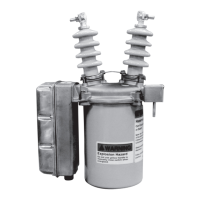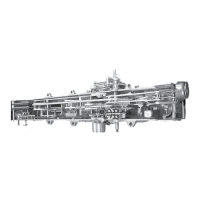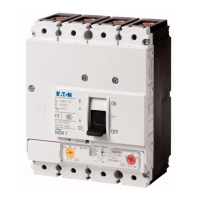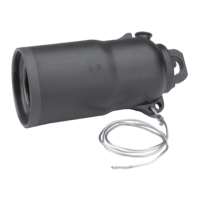No Data Acquisition!—Data failed to be acquired over
a 1 second time period (data is acquired every 512
microseconds, if no data is acquired in one second it
indicates a problem).
VR1 (2, 3) Input Voltage Missing!—The detected or
measured source voltage secondary is below 40 volts for
VR1 (2, 3).
VR1 (2, 3) Output Voltage Missing!—The detected or
measured load voltage secondary is below 40 volts for
VR1 (2, 3).
VR1 (2, 3) No Neutral Sync Signal!—The control tap
position is set to neutral, but the neutral signal from the
tap changer is not present for VR1 (2, 3).
Clock Needs Setting!—The clock has lost power and
must be reset.
Factory Calibration Required!—Control calibrations are out
of range.
Configuration Value Required!—Control settings have not
been set.
Battery Test Failed!—The battery has failed and needs
replacing.
VR1 (2, 3) Motor Trouble!—Motor trouble was detected
and the motor trouble state was set to true.
No neutral sync signal
Control not installed on regulator
This most often occurs when powering up a control on a
workbench or when a control panel has been installed on
a regulator on a tap position other than neutral. The No
Neutral Sync Signal means the control did not have a
neutral signal during the self-test while powering up. This
can occur because there is no 120 V signal present on
the neutral light input. To confirm this and clear the error
message, perform the following:
1. Press ESC.
2. Func, 99, Enter, Admin (default), Enter.
3. Func, 12, Enter.
4. Edit, (some number from one to 16), Enter.
5. Initiate a self-test.
Func, 91, Enter, Enter, Enter.
The (No Neutral Sync Signal) message should not
reappear.
Control on Regulator
If the control is on a regulator and the No Neutral Sync
Signal message appears during power up or self-test, or
there is no neutral light, check the input signal between
terminal NL and G. If the regulator is in neutral, there
should be 120 V at the input. When 120 V is not present at
terminal NL while on neutral, the neutral light on the control
panel will be off.
If there is no neutral light and no neutral light signal at
terminal NL, verify that the regulator is in neutral. For the
regulator to be in neutral, the position indicator should be
on neutral and if the regulator is energized there should not
be a differential voltage between the source (S) bushing and
the load (L) bushing.
When there is no neutral light and the regulator is powered
up either by internal or external power, check these input
points as follows:
If there are TB1 and TB2 terminal boards, check the
voltage between TB2-NL and G, located on the bottom
terminal board on the control assembly back panel:
If there is no voltage and there is voltage at TB1-NL,
the problem is in the connections in the wiring harness
on the back panel. If there is voltage on TB2-NL and no
neutral light, the problem is in the control panel.
TB3-NL or TB1-NL if present located on the top terminal
board on the control assembly back panel:
If there is no voltage, the problem can be in the
connection at this terminal point, the control cable, the
connection in the junction box, or inside the regulator.
JBB-NL, located on the terminal board inside the junction
box and TCB-NL, located on the tap changer:
If there is no voltage, the problem is inside the regulator,
either with connection point JBB-NL under the cover
assembly, connection TCB-NL on the tap-changer, neutral
light switch, or the neutral light actuator segments.
On the current regulator design, the junction box terminal
board consists of automotive-style plug connections.
Check that the plugs are firmly installed. Disconnecting
the plug on the top will allow for a probe to make contact
to check the voltage.
No input voltage
The Input Voltage Missing message occurs when no
input voltage is sensed or it cannot be calculated. The
input voltage is the source voltage from a differential or
source potential transformer. This voltage signal can also be
calculated by the control if FC 39, Source Voltage Calculation
is set to On, the regulator type is properly set at FC 140,
and the tap position is present at FC 12.
When this message is indicated and the regulator has a
differential transformer, check for a voltage between V6
and G, if V6 is present. This voltage will be 0.0 V when
the regulator is in neutral. The voltage will increase as the
regulator is tapped up. When the regulator is at 16 raise,
the voltage will be 11.5 to 12 Vac. If there is no input voltage
shown at FC 7, Source Voltage Secondary, and the regulator
has a differential transformer, the problem could be in the
control, back panel connections, control cable, the junction
box, the junction box terminal board under the cover, or the
differential PT.
If there is not a differential PT on the regulator, turn FC 39
to On. This will supply the calculated voltage signal and
when the self-test is rerun, the input voltage diagnostic
error message will clear.
159
INSTALLATION, OPERATION, AND MAINTENANCE INSTRUCTIONS MN225003EN April 2018
CL-7 Voltage Regulator Control

